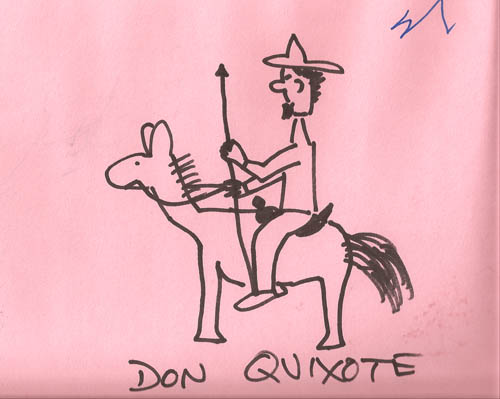SPOILER ALERT! If you’ve never read Don Quixote, be warned: This post will probably give away plot points.
A few minutes ago, I finished reading Don Quixote by Miguel de Cervantes for the first time.

Don Quixote by Jason Crane
All I knew about it before reading it was that it involved a crazy man who thinks he’s a knight and attacks windmills. In fact, I thought the entire book was about Don Quixote attacking various windmills. It’s one of those books that has entered the cultural consciousness even if most folks have never read it. Fess up, did you think, when you were a kid, that the book was called Donkey Hotee? I did, and I always assumed it was because he rode a donkey. Which, it turns out, he doesn’t.
Little did I know — and even less did I expect — what an amazing work it is. It’s beautiful, comical and tragic all at once. It’s a history lesson, a visionary look at the art of the novel, and a gripping story, too.
In many ways, Don Quixote reminded me of Shakespeare’s Hamlet, a work so large and full of so much of the human experience that it’s amazing to consider one person having written it. How could Cervantes and Shakespeare fit so much into a single work? And who were these men that they themselves contained so much wisdom and insight, coupled with the literary talent to set it down in works that will live as long as language? It makes blogging look a bit ridiculous, for one thing. (Hamlet and the first book of Don Quixote were published almost simultaneously. The early 1600s must have been one heck of a time in which to live and read!)
While I was reading the book, I also picked up a few critical studies to read afterward, including Lectures on Don Quixote by Vladimir Nabokov; Meditations on Quixote
by Juan Ortega y Gasset; and The Western Canon
by Harold Bloom.
The book seems on its face to be a comedy about a crazy man, but to me it was an indictment of a society that had forgotten its values and lost its honor. The duke and duchess who torment Don Quixote and Sancho throughout much of Book Two are villians, as far as I can tell. You’d have to be callous and sadistic to find their “jests” funny rather than cruel. However, my interpretation of the book is through my own cultural lens, and Cervantes may have been in favor of the purges of Jews and Moors that he describes, even though a modern reader can see his commentary as criticism.
In fact, Don Quixote and Sancho maintain their dignity throughout the book, and even if that dignity’s foundation can be called into question, they still come off as more honorable and worthwhile human beings than most of the major characters who try to trick or cure them.
To be continued…
Comments